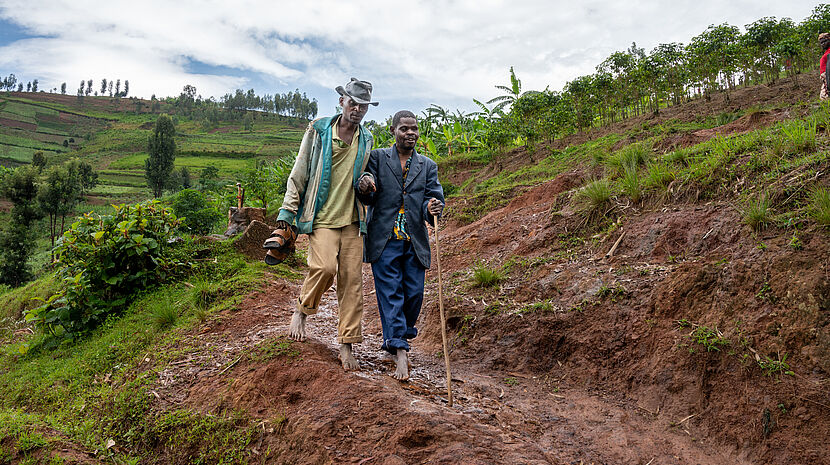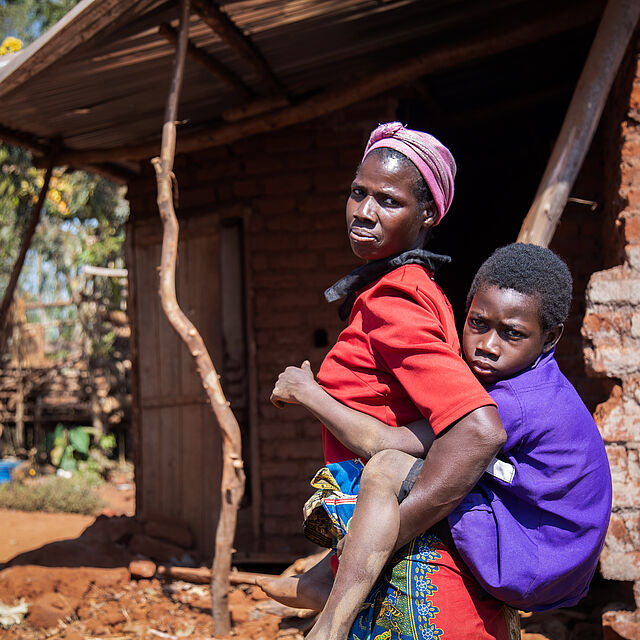Findings from a Global Analysis:
Disability Disaggregated Data in Disaster Risk Reduction

©CBM/argum/Einberger
Our in-depth analysis explores the challenges and opportunities that arise when collecting disability-disaggregated data in disaster-prone contexts and how such data can be used to improve disaster risk reduction programmes.
The global push to weave disability inclusion into governmental strategies, disaster risk reduction (DRR) plans, and humanitarian efforts has seen notable progress in recent years. Yet, the lack of detailed data on the prevalence of disability remains an obstacle. This thwarts efforts to fully understand and address the needs of persons with disabilities in times of crisis. The Washington Group Short Set of Questions (WG-SS) is a promising tool. It bridges this gap by accurately identifying persons with disabilities, especially in disaster-prone areas.
Our comprehensive report results from a project titled “Putting Persons with Disabilities at the Centre of Humanitarian Preparedness and Response.” It highlights findings from seven countries: Bangladesh, Indonesia, Colombia, Myanmar, Niger, Uganda, and Nicaragua. This initiative, driven by a consortium including Arbeiter-Samariter-Bund Deutschland e.V. (ASB), Centre for Disability in Development (CDD), Christoffel-Blindenmission – Christian Blind Mission e.V. (CBM), the International Disability Alliance (IDA), Malteser Hilfsdienst e.V. – Malteser International Europe (MI), and local partners. It is supported financially by the German Federal Foreign Office (GFFO). The initiative explores the application and effectiveness of the WG-SS in capturing disability disaggregated data.
Findings
Key findings from the analysis reveal not only the varied prevalence rates of disability, ranging from 4.2% in Niger to a striking 29% in Myanmar. These discrepancies highlight the need for detailed, tailored approaches to Disability Inclusive Disaster Risk Reduction (DiDRR).
Beyond the differences in prevalence rates the synthesis revealed the following key findings:
- Diversity in the types of impairment: All types of impairment were identified in the seven countries. However, physical and visual impairments are the most prevalent groups. This finding highlights the importance of context-specific analyses and interventions.
- Intersectionality of impairments: The data show a common occurrence of intersecting disabilities. For example, the coexistence of visual and hearing impairments.
- Gender and age dynamics: Disparities in gender and age distribution make things even more complicated. In most countries, there are more women with disabilities. In addition, the 60 and older age group is the largest demographic with impairments. This highlights the need for age-sensitive approaches.
- Challenges in DRM planning and participation: The insufficient inclusion of people with disabilities in disaster risk reduction was glaring.
- Barriers and enablers: Environmental barriers are a prevalent obstacle to inclusion in DRR initiatives. They emphasise the need for infrastructural adjustments. Attitudinal barriers are also a challenge and emphasise the need for an inclusive mindset. On a positive note, assistive devices and accessible information make a crucial contribution to inclusion. They support the participation of persons with disabilities in humanitarian preparedness and response.
Challenges
However, the report also recognises that data collection is limited due to improper administration of the WG-SS in some countries. For example, pre-selection in Uganda, Colombia, Nicaragua, and Indonesia leads to high disability rates and makes it difficult to compare data across countries. It emphasises the need for thorough training of enumerators to ensure accurate and unbiased data collection. This aspect highlights the critical role of methodological rigour and the avoidance of pre-selection bias in the survey samples in order to increase the reliability of the findings.
To summarise, our analysis not only sheds light on the current landscape of disability inclusion in disaster response and humanitarian contexts. It also lays out a roadmap for improving data collection practices and tailoring interventions. These efforts aim to meet the nuanced needs of persons with disabilities across the globe. These efforts are a step forward towards a more inclusive society. A society in which the rights and potential of all people, regardless of their disabilities, are fully realised.

Disability Disaggregated Data in Disaster Risk Reduction: Findings and Lessons Learned
Learn more about the central role of the Washington Group Short Set of Questions in identifying disabilities and how nuanced approaches can lead to more effective disaster risk reduction and inclusive societies.
Get the report here